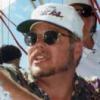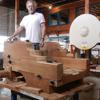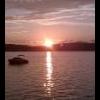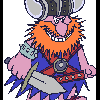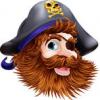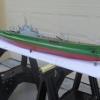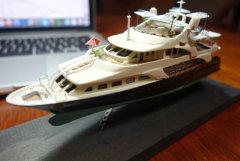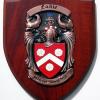MORE HANDBOOKS ARE ON THEIR WAY! We will let you know when they get here.
×
-
Posts
938 -
Joined
-
Last visited
Reputation Activity
-
 shipmodel got a reaction from ggrieco in Bomb Vessel Granado 1742 by gjdale - FINISHED - 1/48 - Cross-Section
shipmodel got a reaction from ggrieco in Bomb Vessel Granado 1742 by gjdale - FINISHED - 1/48 - Cross-Section
Hi Grant -
I join with everyone else in admiring your deadeyes. Very nice work.
Sorry about the chainplates. At least they gave out now rather than when you tried to rig the shrouds. There is a lot of stress here, and soldering, even silver soldering has never held up for me. Here is how I worked out the issue on the Queen Anne's Revenge, whose chainplates look a lot like yours:
The upper hook is narrowed to fit the loop of the deadeye strop. Once the deadeye is installed the loop is closed and soldered. It is also strengthened by being sandwiched between the channel and the cap molding so it cannot open. I did not have any failures during rigging.
I really enjoy your log and how you are solving the problems that come up. Thanks for sharing.
Dan
-
 shipmodel got a reaction from usedtosail in Bomb Vessel Granado 1742 by gjdale - FINISHED - 1/48 - Cross-Section
shipmodel got a reaction from usedtosail in Bomb Vessel Granado 1742 by gjdale - FINISHED - 1/48 - Cross-Section
Hi Grant -
I join with everyone else in admiring your deadeyes. Very nice work.
Sorry about the chainplates. At least they gave out now rather than when you tried to rig the shrouds. There is a lot of stress here, and soldering, even silver soldering has never held up for me. Here is how I worked out the issue on the Queen Anne's Revenge, whose chainplates look a lot like yours:
The upper hook is narrowed to fit the loop of the deadeye strop. Once the deadeye is installed the loop is closed and soldered. It is also strengthened by being sandwiched between the channel and the cap molding so it cannot open. I did not have any failures during rigging.
I really enjoy your log and how you are solving the problems that come up. Thanks for sharing.
Dan
-
 shipmodel got a reaction from WackoWolf in Bomb Vessel Granado 1742 by gjdale - FINISHED - 1/48 - Cross-Section
shipmodel got a reaction from WackoWolf in Bomb Vessel Granado 1742 by gjdale - FINISHED - 1/48 - Cross-Section
Hi Grant -
I join with everyone else in admiring your deadeyes. Very nice work.
Sorry about the chainplates. At least they gave out now rather than when you tried to rig the shrouds. There is a lot of stress here, and soldering, even silver soldering has never held up for me. Here is how I worked out the issue on the Queen Anne's Revenge, whose chainplates look a lot like yours:
The upper hook is narrowed to fit the loop of the deadeye strop. Once the deadeye is installed the loop is closed and soldered. It is also strengthened by being sandwiched between the channel and the cap molding so it cannot open. I did not have any failures during rigging.
I really enjoy your log and how you are solving the problems that come up. Thanks for sharing.
Dan
-
 shipmodel got a reaction from CaptainSteve in Bomb Vessel Granado 1742 by gjdale - FINISHED - 1/48 - Cross-Section
shipmodel got a reaction from CaptainSteve in Bomb Vessel Granado 1742 by gjdale - FINISHED - 1/48 - Cross-Section
Hi Grant -
I join with everyone else in admiring your deadeyes. Very nice work.
Sorry about the chainplates. At least they gave out now rather than when you tried to rig the shrouds. There is a lot of stress here, and soldering, even silver soldering has never held up for me. Here is how I worked out the issue on the Queen Anne's Revenge, whose chainplates look a lot like yours:
The upper hook is narrowed to fit the loop of the deadeye strop. Once the deadeye is installed the loop is closed and soldered. It is also strengthened by being sandwiched between the channel and the cap molding so it cannot open. I did not have any failures during rigging.
I really enjoy your log and how you are solving the problems that come up. Thanks for sharing.
Dan
-
 shipmodel reacted to gjdale in Bomb Vessel Granado 1742 by gjdale - FINISHED - 1/48 - Cross-Section
shipmodel reacted to gjdale in Bomb Vessel Granado 1742 by gjdale - FINISHED - 1/48 - Cross-Section
And now to the not so successful story...
Chainplates
I had a brainwave about making the chain plates, and was absolutely convinced this was going to work! The drawing below shows the chainplate (#8) as having a tubular-like section at the top, through which the strop for the deadeye passes.
Having thought about this for a few days, I devised a cunning plan. I took a sheet of 1/32” thick brass flat bar, and a piece of 3/32” OD brass tubing, and silver soldered them together.
I even devised a way to support the flat bar so that it remained level with the centre of the tubing. Here is what it looked like after soldering – not pretty.
Not to worry, a bit of a clean up with a file and some sand paper, and it’s looking much better:
And just to prove that I managed to get it centred properly:
The next problem to solve was how to slice off pieces of the correct thickness to fit into the milled slots in the Channel boards. I first had to decide how to hold and cut the work. No problem – rotate the mill head 90-degrees and attach a slitting saw. Make up a sacrificial holding board for the brass stock, with a small channel cut into it to seat the tubing while keeping the flat-bar flat. Mount said piece in mill vise and we’re ready to cut – almost….
The slots in the Channel boards were milled with a 1/16” mill, so that was the maximum width for each slice. My mill handwheels are calibrated in millimetres (1/16” = 1.59 mm) and I planned to use a slitting saw that has a kerf of 0.6 mm. I decided that if I went for a slice thickness of 1.4 mm, I would allow myself a tiny bit of wiggle room, while at the same time making the Mill work easier as I would need to advance the X-axis handwheel exactly 2 mm (ie 2 complete rotations) for each slice. I then simply set the depth of cut to 2.5mm (just over the 3/32” thickness of the tubing), and advanced the Y-axis into the saw – carefully, and slowly. This part of the operation worked like a charm. You can see in the following shot, how the process looks part way through.
And here are the resulting pieces – a test fit showed they fit into the Channel slots perfectly.
A 0.8mm hole was drilled in the end of each piece to take a securing nail, and the chainplates were then carefully bent to the approximate shape shown in the drawings.
At this stage I was feeling pretty darned pleased with myself! My success, however, was short lived and it was at this point that success finished and catastrophic failure took over!
I made up some deadeye strops from 0.75mm brass wire. This had to be inserted through the tube part of the chainplate before being soldered closed. The parts were then all cleaned with a wire wheel in a rotary tool, and chemically blackened (using Jax Pewter Black, as it also blackens solder). It was then time to insert the deadeyes and squeeze the strops tight around them and the top of the tube. Two things happened here – both failures of the soldering process. Either the tube parted company with the rest of the chainplate, or the strop soldering point gave way, or both. Either way, I had a greater than 75% failure rate, and the remaining 25% were looking a bit dodgy too. Several days’ work down the tube, but learning (of sorts) has taken place! Back to the drawing board……
-
 shipmodel reacted to usedtosail in USS Constitution by usedtosail - FINISHED - Model Shipways - scale 1/76
shipmodel reacted to usedtosail in USS Constitution by usedtosail - FINISHED - Model Shipways - scale 1/76
Thanks Boyd. I am certainly in no hurry with this build and I enjoy looking ahead, but I can't look too far ahead or I get depressed.
Work on the gun port lids continues. First, here are the two full port lids on each side with their draw lines installed to open them. I went with a modified version of the lines on the current Conny. I glued the top lines onto the back of the eye brows after threading them through the holes. I then glued the eye brows in place, and tied the other end of those lines to the lines running into the bottom corners of the lids.
The remaining eye brows (there has to be a better term for these, no?) are all going over half ports or canvas covered ports which do not have draw lines. So I first primed them, which involves a pickling step in white vinegar before painting with primer. I then filled the holes with wood filler and smoothed the filler out after it set for a few minutes.
When the filler was fully dry, I gave the parts two coats of black paint. Here they are with some of the half port lids currently being painted.
These are the remaining port lids for the starboard side and are ready to install. I already installed four of these on the starboard side. These use the L shaped hinge brackets I made which worked really well to support these half lids. They provide supports like shelf brackets while I was still able to glue the back edges of the ports to the hull. Between both attachments, these seem very sturdy. I will have pictures of these installed in a future post. I went ahead and made all of the hinge brackets for the port side and blackened them. I also cut all of the wood pieces for the port gun lids and have started adding the hinges to them and will start painting them soon.
I have been going back and forth on the canvas coverings for those gun ports near the galleries, as you can see by the previous posts. I tried making the frames last night from manila folder material, but could not get them to look good, especially the circular sections. I then tried some thin styrene strip, thinking I could use that for the straight sections of the frames and come up with something for the circle later. I removed one of the canvas covers from the model and glued styrene strips to the four edges to see how this might look as a frame before adding the diagonal pieces.
I placed it into the gun port opening and was not happy with the look at the joints of the frame pieces. I then thought to try turning the piece around with the frame on the inside of the port hidden by the canvas, fit into the rabbet around the port. I was really happy with this look, and removed all of the canvas covers and framed them this way. Here is how they came out and here is how they are going to stay. I think this is a nice compromise between what may have been and what I can make look have way decent. The edges look much better than the raw fabric edges that I first had.
I do really appreciate the suggestions so please keep them coming, even if I don't always follow them. They do push me to do better.
-
 shipmodel reacted to KenW in Rattlesnake by KenW - FINISHED - Model Shipways - Scale 1:64 - American Privateer
shipmodel reacted to KenW in Rattlesnake by KenW - FINISHED - Model Shipways - Scale 1:64 - American Privateer
I finally completed the cheeks and mounted them on the stem, along with the wolf-hounds. ‘Martin W’ was right – the wolf hounds were a bit too large. In fact, even though the carved wolfs were the exact size as those on the MS plans, the stem wasn’t the same size as the plans. So I had to make the cheeks narrower and modify the carvings in order to manage to fit them on the model. They don’t look as I imaged them, but I think they’re OK. The cheeks were laminated to get the look I wanted.
I also created small laminated pieces to enable the covering boards to look like they curved around at 180 degrees. I think the result looks pretty good.
Now I'll continue working on the head.
-
 shipmodel got a reaction from Canute in SS Andrea Doria 1952 by shipmodel - FINISHED - 1/16" scale
shipmodel got a reaction from Canute in SS Andrea Doria 1952 by shipmodel - FINISHED - 1/16" scale
Hi all. Yes, i think my customer will be pleased. With some small exceptions I am happy with it too, which is not the same thing at all.
Tom - I go over my flag method in the Queen Anne's Revenge log. It is spelled out in some length on page 11, but here is a shorter version:
I find a digital image of the flag on the net and import it into my PhotoShop program. I use an older, middle priced version called Elements 10, but there are lots of similar programs which can do similar things. In PhotoShop I resize the image and then skew down the outer end of the flag so it becomes a parallelogram. Doing this allows the flag to hang more naturally, without a buildup of material at the lower inside corner. Here is a screen capture of the PhotoShop program with the Image/Transform/Skew menus opened and the original and skewed images of the flag shown.
Then it is just a question of selecting the material that fits my scale; silkspan here and batik for the QAR. I do print it out onto a test piece of paper first, using just a home inkjet printer. I tape a smaller piece of silkspan over the image, then print again over the top. It gets sealed, then cut out with a little extra to secure it to the halyard, hung and curled till I like the look. Hope that explains it.
Thanks again for the compliments and for following along.
Be well.
Dan
-
 shipmodel got a reaction from Piet in SS Kaiser Wilhelm der Grosse 1897 by Mirabell61 - FINISHED - scale 1:144 - POF - first German four stacker of the Norddeutscher Lloyd line
shipmodel got a reaction from Piet in SS Kaiser Wilhelm der Grosse 1897 by Mirabell61 - FINISHED - scale 1:144 - POF - first German four stacker of the Norddeutscher Lloyd line
Hi Nils and Happy New Year to you too.
I will be following along this coming year and looking forward to many excellent developments.
Be well
Dan
-
 shipmodel got a reaction from Omega1234 in SS Andrea Doria 1952 by shipmodel - FINISHED - 1/16" scale
shipmodel got a reaction from Omega1234 in SS Andrea Doria 1952 by shipmodel - FINISHED - 1/16" scale
Hi all. Yes, i think my customer will be pleased. With some small exceptions I am happy with it too, which is not the same thing at all.
Tom - I go over my flag method in the Queen Anne's Revenge log. It is spelled out in some length on page 11, but here is a shorter version:
I find a digital image of the flag on the net and import it into my PhotoShop program. I use an older, middle priced version called Elements 10, but there are lots of similar programs which can do similar things. In PhotoShop I resize the image and then skew down the outer end of the flag so it becomes a parallelogram. Doing this allows the flag to hang more naturally, without a buildup of material at the lower inside corner. Here is a screen capture of the PhotoShop program with the Image/Transform/Skew menus opened and the original and skewed images of the flag shown.
Then it is just a question of selecting the material that fits my scale; silkspan here and batik for the QAR. I do print it out onto a test piece of paper first, using just a home inkjet printer. I tape a smaller piece of silkspan over the image, then print again over the top. It gets sealed, then cut out with a little extra to secure it to the halyard, hung and curled till I like the look. Hope that explains it.
Thanks again for the compliments and for following along.
Be well.
Dan
-
 shipmodel got a reaction from CaptainSteve in USS Constitution by usedtosail - FINISHED - Model Shipways - scale 1/76
shipmodel got a reaction from CaptainSteve in USS Constitution by usedtosail - FINISHED - Model Shipways - scale 1/76
Tom -
Thanks for showing the artwork. To my mind this does not look like a cannon muzzle, but perhaps a wooden framework that the canvas was mounted to. The circle with outward rays was a common pattern for glass windows at the time. It is very different from the artist's drawing of the cannon in the port on the right. A wooden framework could also solve the problem of how to secure the canvas in the port since it did not have to roll down.
The photo is of the reconstructed L'Hermione.
Dan
-
 shipmodel got a reaction from GLakie in USS Constitution by usedtosail - FINISHED - Model Shipways - scale 1/76
shipmodel got a reaction from GLakie in USS Constitution by usedtosail - FINISHED - Model Shipways - scale 1/76
Tom -
Looks like it could go either way. Looking forward to seeing how it comes out.
Be well
Dan
-
 shipmodel got a reaction from popeye the sailor in USS Constitution by usedtosail - FINISHED - Model Shipways - scale 1/76
shipmodel got a reaction from popeye the sailor in USS Constitution by usedtosail - FINISHED - Model Shipways - scale 1/76
Tom -
Thanks for showing the artwork. To my mind this does not look like a cannon muzzle, but perhaps a wooden framework that the canvas was mounted to. The circle with outward rays was a common pattern for glass windows at the time. It is very different from the artist's drawing of the cannon in the port on the right. A wooden framework could also solve the problem of how to secure the canvas in the port since it did not have to roll down.
The photo is of the reconstructed L'Hermione.
Dan
-
 shipmodel reacted to usedtosail in USS Constitution by usedtosail - FINISHED - Model Shipways - scale 1/76
shipmodel reacted to usedtosail in USS Constitution by usedtosail - FINISHED - Model Shipways - scale 1/76
Oh, that picture is worth a lot. I totally misinterpreted the original. That said, here are the other two pictures referenced. The first one here looks just like the picture you sent with no gun. The bottom one looks like it has a gun in it. So I guess that hole would allow a gun to poke through. I like the frame though and will attempt to recreate that look. Thank you very much.
-
 shipmodel got a reaction from Omega1234 in SS Kaiser Wilhelm der Grosse 1897 by Mirabell61 - FINISHED - scale 1:144 - POF - first German four stacker of the Norddeutscher Lloyd line
shipmodel got a reaction from Omega1234 in SS Kaiser Wilhelm der Grosse 1897 by Mirabell61 - FINISHED - scale 1:144 - POF - first German four stacker of the Norddeutscher Lloyd line
Hi Nils and Happy New Year to you too.
I will be following along this coming year and looking forward to many excellent developments.
Be well
Dan
-
 shipmodel reacted to Mirabell61 in SS Andrea Doria 1952 by shipmodel - FINISHED - 1/16" scale
shipmodel reacted to Mirabell61 in SS Andrea Doria 1952 by shipmodel - FINISHED - 1/16" scale
Congrats Dan,
with the AD you have modeled a fantastic built passenger liner. a real little memorial of a great ship that wo`nt be forgotten
Well done !!
Nils
-
 shipmodel reacted to druxey in SS Andrea Doria 1952 by shipmodel - FINISHED - 1/16" scale
shipmodel reacted to druxey in SS Andrea Doria 1952 by shipmodel - FINISHED - 1/16" scale
Congratulations on completion of a years' work, Dan. Andrea looks great. I hope that your client is very happy with the end result.
-
 shipmodel reacted to usedtosail in SS Andrea Doria 1952 by shipmodel - FINISHED - 1/16" scale
shipmodel reacted to usedtosail in SS Andrea Doria 1952 by shipmodel - FINISHED - 1/16" scale
Thank you Dan for the details on the flag. I like that method a lot and will be trying it in the future.
-
 shipmodel reacted to michael mott in SS Andrea Doria 1952 by shipmodel - FINISHED - 1/16" scale
shipmodel reacted to michael mott in SS Andrea Doria 1952 by shipmodel - FINISHED - 1/16" scale
Great work Dan, thanks for sharing the construction details, some of them have been filed away for future use.
Michael
-
 shipmodel got a reaction from GLakie in USS Constitution by usedtosail - FINISHED - Model Shipways - scale 1/76
shipmodel got a reaction from GLakie in USS Constitution by usedtosail - FINISHED - Model Shipways - scale 1/76
Tom -
Thanks for showing the artwork. To my mind this does not look like a cannon muzzle, but perhaps a wooden framework that the canvas was mounted to. The circle with outward rays was a common pattern for glass windows at the time. It is very different from the artist's drawing of the cannon in the port on the right. A wooden framework could also solve the problem of how to secure the canvas in the port since it did not have to roll down.
The photo is of the reconstructed L'Hermione.
Dan
-
 shipmodel got a reaction from GLakie in USS Constitution by usedtosail - FINISHED - Model Shipways - scale 1/76
shipmodel got a reaction from GLakie in USS Constitution by usedtosail - FINISHED - Model Shipways - scale 1/76
Hi Tom -
Just looked over this log and was quite impressed. You are getting excellent results technically and artistically, and with full attention to historic accuracy. Bravo.
I am no Constitution expert, and I have not looked at any of the artwork that was mentioned, but I am wondering about those canvas gunport covers. The reason for canvas rather than wood, I would think, was so the captain could roll them down a bit to get some air without having to open them fully, or at least halfway by removing the upper split cover. In that case, would there have been a hole, or would the cannon be stowed inboard somewhere with a solid canvas curtain to cover the port?
Just my brain spinning along. If I am way off base, just ignore this.
Be well
Dan
-
 shipmodel got a reaction from michael mott in SS Andrea Doria 1952 by shipmodel - FINISHED - 1/16" scale
shipmodel got a reaction from michael mott in SS Andrea Doria 1952 by shipmodel - FINISHED - 1/16" scale
Hi all. Yes, i think my customer will be pleased. With some small exceptions I am happy with it too, which is not the same thing at all.
Tom - I go over my flag method in the Queen Anne's Revenge log. It is spelled out in some length on page 11, but here is a shorter version:
I find a digital image of the flag on the net and import it into my PhotoShop program. I use an older, middle priced version called Elements 10, but there are lots of similar programs which can do similar things. In PhotoShop I resize the image and then skew down the outer end of the flag so it becomes a parallelogram. Doing this allows the flag to hang more naturally, without a buildup of material at the lower inside corner. Here is a screen capture of the PhotoShop program with the Image/Transform/Skew menus opened and the original and skewed images of the flag shown.
Then it is just a question of selecting the material that fits my scale; silkspan here and batik for the QAR. I do print it out onto a test piece of paper first, using just a home inkjet printer. I tape a smaller piece of silkspan over the image, then print again over the top. It gets sealed, then cut out with a little extra to secure it to the halyard, hung and curled till I like the look. Hope that explains it.
Thanks again for the compliments and for following along.
Be well.
Dan
-
 shipmodel got a reaction from Jack12477 in SS Andrea Doria 1952 by shipmodel - FINISHED - 1/16" scale
shipmodel got a reaction from Jack12477 in SS Andrea Doria 1952 by shipmodel - FINISHED - 1/16" scale
Hi all. Yes, i think my customer will be pleased. With some small exceptions I am happy with it too, which is not the same thing at all.
Tom - I go over my flag method in the Queen Anne's Revenge log. It is spelled out in some length on page 11, but here is a shorter version:
I find a digital image of the flag on the net and import it into my PhotoShop program. I use an older, middle priced version called Elements 10, but there are lots of similar programs which can do similar things. In PhotoShop I resize the image and then skew down the outer end of the flag so it becomes a parallelogram. Doing this allows the flag to hang more naturally, without a buildup of material at the lower inside corner. Here is a screen capture of the PhotoShop program with the Image/Transform/Skew menus opened and the original and skewed images of the flag shown.
Then it is just a question of selecting the material that fits my scale; silkspan here and batik for the QAR. I do print it out onto a test piece of paper first, using just a home inkjet printer. I tape a smaller piece of silkspan over the image, then print again over the top. It gets sealed, then cut out with a little extra to secure it to the halyard, hung and curled till I like the look. Hope that explains it.
Thanks again for the compliments and for following along.
Be well.
Dan
-
 shipmodel got a reaction from Tony Hunt in SS Andrea Doria 1952 by shipmodel - FINISHED - 1/16" scale
shipmodel got a reaction from Tony Hunt in SS Andrea Doria 1952 by shipmodel - FINISHED - 1/16" scale
Build Log 15 – Final Details
Hi and Happy New Year to all, and thanks as ever for the likes and comments.
This will be the last installment of this build log, covering the final details that add another level of interest to the model. Many of these are elements that can be changed at the discretion of the captain, so I used as my guide the photographs taken at the time of the sinking.
The first detail was the wires for the short wave radio antenna. These do not show up very well in photographs since they are so thin. On the plans they are shown, but not separated from the mast support wires. Close examination of various photographs show that not all of these wires were installed on the actual ship. Presumably the antenna wires changed as the radio was upgraded during the life of the ship.
There is a cylindrical structure on the starboard side of the Sun Deck just aft of the Command Deck area. Several wires lead to it so, although it is never identified, it is clearly part of the radio system.
Without any clear guide, I decided to include three wires for the antenna. Two lead from near the top of the mast to thin poles at the aft ends, port and starboard, on the Lido Deck. The antenna wires are separated from the poles by short lines with three insulators. These were made by mixing white paint with white glue, then attaching small drops to the line with a toothpick. Several coats were needed since the glue shrinks as it dries and had to be filled out again.
The third line runs from a bit lower on the mast to the top of the funnel. All three lines are then connected to the radio fitting with vertical lines. All of the radio wires were made from fine embroidery linen in an off-white tone. I tried several other materials and colors, but this gave the best look, in my opinion. It is light enough to show up in most light, but thin enough not to be overpowering.
In photographs of the ship taken on different days, there appear or disappear various sets of canvas railing cloths to protect the passengers from sea spray. These were hung on the outside of the railings and laced to them. On the day of the sinking there were railing cloths up to the level of the boat deck and around the command deck.
I modeled the cloths with stiffened batik fabric cut to fit and glued against the appropriate railings. Unfortunately, once everything was dry the fabric proved too transparent, and had to be given a coat of opaque white acrylic. But the glue proved too strong and I risked damage to the rails, so the first ones had to be hand painted on the model, while I could paint later ones before installation. Live and learn, eh?
I was surprised at how much of a visual difference the cloths made to the overall appearance of the model, especially when viewed from amidships. Here are before and after photos.
The passengers were also protected from the weather and sun by canvas awnings supported by metal frames, although no photo shows the awnings spread. Perhaps that was only done in port. The simple frames on the Lido deck are mostly hidden behind the lifeboats, so I did not model them, but the aft taffrail deck was set up with a large awning over a complicated and interesting metal frame. It would be a nice element to include.
The frame was made up of four flat arches of differing widths set across the deck and tilting down from forward to aft. They were connected to each other with a straight bar running along the centerline.
For the model the frames were bent up from 0.030” brass rod. Getting them to fit predrilled holes in the deck and still have the correct arch took a lot of trials and even more errors. Once they were shaped the problems first started. I planned to solder them together in a jig, then electroplate them in chrome. I was spectacularly unsuccessful. Once soldered in the jig, the assembly bent and/or came apart as it was removed. Several times. Metalworking skills are not my strong suit. I never even attempted electroplating. The final solution was to mount the arches on the model with the connecting bar attached with small dots of epoxy. Once everything was set in place the deck was protected with a piece of paper toweling and the brass was hand painted with primer then silver acrylic paint. Happily, it turned out to be quite strong and convincingly metallic.
Some small details were added around the ship. A dozen green storage bins were scattered around, a searchlight was installed on the aft end of the Promenade Deck near the third class pool, and photoetched life preserver rings were mounted outside of the railing cloths on the boat deck. Ensign staffs were mounted at the extreme bow and stern. All of these give the model a bit more 'texture' and realism.
It was finally time, a year after laying the keel, to hang the flag on the ship and get her ready for launch. It was made in my usual way by printing out a skewed image of the flag. At this scale the material was silkspan, which is transparent enough that I did not have to print the reverse side. It was hung on a halyard running from the tip of a gaff to a cleat on the base of the mast, then misted with water and gently curled.
There was one final detail to attend to. You may have noticed in earlier photographs of the first and second class pools that a clock was mounted on the overhang at the forward end of each area.
I made them up from 1/10” o.d. brass tubing filled with a wooden dowel. After flush sanding the wood the brass bezel was chamfered on a sanding belt. The wooden face was painted white. Tiny black dots for the numbers were touched on with the tip of a sharpened toothpick. With my finest 10/0 brush the hands were put on. The extreme close-up photos show that I was less than perfect, but with the entire clock being less than 1/8" in diameter, I have reached the limits of my talents.
The clocks are set to 11:05 p.m. In five minutes the lives of Linda Morgan’s parents, sister, and dozens of others will end and she will be thrust into unwanted publicity. In just five minutes.
But for now, in miniature, she sails off the workbench to the customer.
I hope you liked the journey despite my sometimes clunky sense of humor. I will post a photo tour of the finished model when I can. Until then . . .
Be well
Dan
-
 shipmodel got a reaction from GrandpaPhil in SS Andrea Doria 1952 by shipmodel - FINISHED - 1/16" scale
shipmodel got a reaction from GrandpaPhil in SS Andrea Doria 1952 by shipmodel - FINISHED - 1/16" scale
Build Log 15 – Final Details
Hi and Happy New Year to all, and thanks as ever for the likes and comments.
This will be the last installment of this build log, covering the final details that add another level of interest to the model. Many of these are elements that can be changed at the discretion of the captain, so I used as my guide the photographs taken at the time of the sinking.
The first detail was the wires for the short wave radio antenna. These do not show up very well in photographs since they are so thin. On the plans they are shown, but not separated from the mast support wires. Close examination of various photographs show that not all of these wires were installed on the actual ship. Presumably the antenna wires changed as the radio was upgraded during the life of the ship.
There is a cylindrical structure on the starboard side of the Sun Deck just aft of the Command Deck area. Several wires lead to it so, although it is never identified, it is clearly part of the radio system.
Without any clear guide, I decided to include three wires for the antenna. Two lead from near the top of the mast to thin poles at the aft ends, port and starboard, on the Lido Deck. The antenna wires are separated from the poles by short lines with three insulators. These were made by mixing white paint with white glue, then attaching small drops to the line with a toothpick. Several coats were needed since the glue shrinks as it dries and had to be filled out again.
The third line runs from a bit lower on the mast to the top of the funnel. All three lines are then connected to the radio fitting with vertical lines. All of the radio wires were made from fine embroidery linen in an off-white tone. I tried several other materials and colors, but this gave the best look, in my opinion. It is light enough to show up in most light, but thin enough not to be overpowering.
In photographs of the ship taken on different days, there appear or disappear various sets of canvas railing cloths to protect the passengers from sea spray. These were hung on the outside of the railings and laced to them. On the day of the sinking there were railing cloths up to the level of the boat deck and around the command deck.
I modeled the cloths with stiffened batik fabric cut to fit and glued against the appropriate railings. Unfortunately, once everything was dry the fabric proved too transparent, and had to be given a coat of opaque white acrylic. But the glue proved too strong and I risked damage to the rails, so the first ones had to be hand painted on the model, while I could paint later ones before installation. Live and learn, eh?
I was surprised at how much of a visual difference the cloths made to the overall appearance of the model, especially when viewed from amidships. Here are before and after photos.
The passengers were also protected from the weather and sun by canvas awnings supported by metal frames, although no photo shows the awnings spread. Perhaps that was only done in port. The simple frames on the Lido deck are mostly hidden behind the lifeboats, so I did not model them, but the aft taffrail deck was set up with a large awning over a complicated and interesting metal frame. It would be a nice element to include.
The frame was made up of four flat arches of differing widths set across the deck and tilting down from forward to aft. They were connected to each other with a straight bar running along the centerline.
For the model the frames were bent up from 0.030” brass rod. Getting them to fit predrilled holes in the deck and still have the correct arch took a lot of trials and even more errors. Once they were shaped the problems first started. I planned to solder them together in a jig, then electroplate them in chrome. I was spectacularly unsuccessful. Once soldered in the jig, the assembly bent and/or came apart as it was removed. Several times. Metalworking skills are not my strong suit. I never even attempted electroplating. The final solution was to mount the arches on the model with the connecting bar attached with small dots of epoxy. Once everything was set in place the deck was protected with a piece of paper toweling and the brass was hand painted with primer then silver acrylic paint. Happily, it turned out to be quite strong and convincingly metallic.
Some small details were added around the ship. A dozen green storage bins were scattered around, a searchlight was installed on the aft end of the Promenade Deck near the third class pool, and photoetched life preserver rings were mounted outside of the railing cloths on the boat deck. Ensign staffs were mounted at the extreme bow and stern. All of these give the model a bit more 'texture' and realism.
It was finally time, a year after laying the keel, to hang the flag on the ship and get her ready for launch. It was made in my usual way by printing out a skewed image of the flag. At this scale the material was silkspan, which is transparent enough that I did not have to print the reverse side. It was hung on a halyard running from the tip of a gaff to a cleat on the base of the mast, then misted with water and gently curled.
There was one final detail to attend to. You may have noticed in earlier photographs of the first and second class pools that a clock was mounted on the overhang at the forward end of each area.
I made them up from 1/10” o.d. brass tubing filled with a wooden dowel. After flush sanding the wood the brass bezel was chamfered on a sanding belt. The wooden face was painted white. Tiny black dots for the numbers were touched on with the tip of a sharpened toothpick. With my finest 10/0 brush the hands were put on. The extreme close-up photos show that I was less than perfect, but with the entire clock being less than 1/8" in diameter, I have reached the limits of my talents.
The clocks are set to 11:05 p.m. In five minutes the lives of Linda Morgan’s parents, sister, and dozens of others will end and she will be thrust into unwanted publicity. In just five minutes.
But for now, in miniature, she sails off the workbench to the customer.
I hope you liked the journey despite my sometimes clunky sense of humor. I will post a photo tour of the finished model when I can. Until then . . .
Be well
Dan


